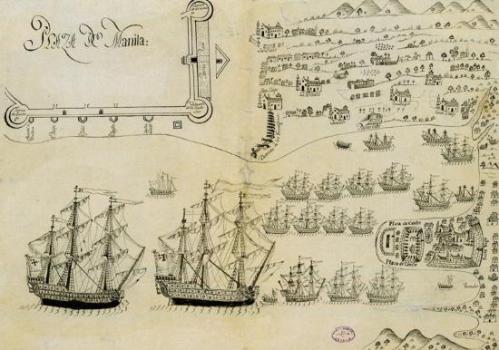Kahit ako na-amazed dito. First time ko nakita tong mga pictures ng old manila where i grow. Hindi ko pa to nakita kahit saang history books na nabasa ko. Tignan nyo.
The city of Manila. Oil painting on the inside of a wooden chest, circa 1640-50. Museo de Arte Jose Luis Bello, Puebla. Mexico. After the 1645 earthquake Manila was reconstructed. By the end of the 17th century, Intramuros had some six hundred houses that were protected by its stone walls.
The city of Manila. AGI Manila was undoubtedly the center of the port life of the Philippines, and shared this task with the naval arsenal of Cavite; they were, in a sense, complementary cities.
The Castle of Santiago in the city of Manila. Juan de Ciscara. 1714. AGI The Santiago fortress was built between 1596 and 1602 on the land promontory between the sea and the Pasig River, and was the most important fortification built in Manila. The walls encircling the city started at this point.
Manila Bay. Rafael Cerero. 1888. SGE Corregidor Island divides the entrance to the bay into two channels: one is the “Boca Chica”, which separates the island from Punta Lasirí, and the other is “Boca Grande”, which separates Pulo Caballo and Punta Restringa. Twenty-five miles ahead of them is the city of Manila.
Ground plan of a fortress in Manila. AGI Luzon was the best defended island. From its beginnings, Manila attempted to fortify itself as it was a strategically important point on the route linking China with Cádiz.
View of the bay and the city of Manila. Engraving made by Francisco Javier de Herrera. 1818. SHM The beautiful bay of Manila with its limpid waters was admired by all travelers and seamen putting into port on the coasts of the island of Luzon. It was used as an anchorage by the ships arriving from the principal trading center of Asia and America.
View of the city of Manila from Bagumbayan. Engraving made by Esteve. 1818. SHM In 1581, ten years after its founding, Manila received the title of “Insigne” (noble) and “Leal” (loyal), and became an episcopal seat under the control of Mexico after the proclamation of a papal bull.
The Pasig River in the city of Manila. Fernando Brambila. Collection of drawings and engravings made on the Malaspina Expedition. 1789-1794. MN The city of Manila was founded near to the mouth of the great Pasig River, which was navigable as far as its source at the Laguna de Bay. Up until the 19th century, only one stone-built bridge connected the fortified precinct with the districts on the opposite bank.








Leave a comment